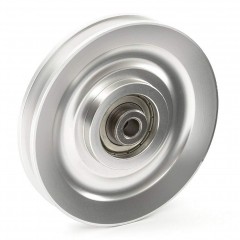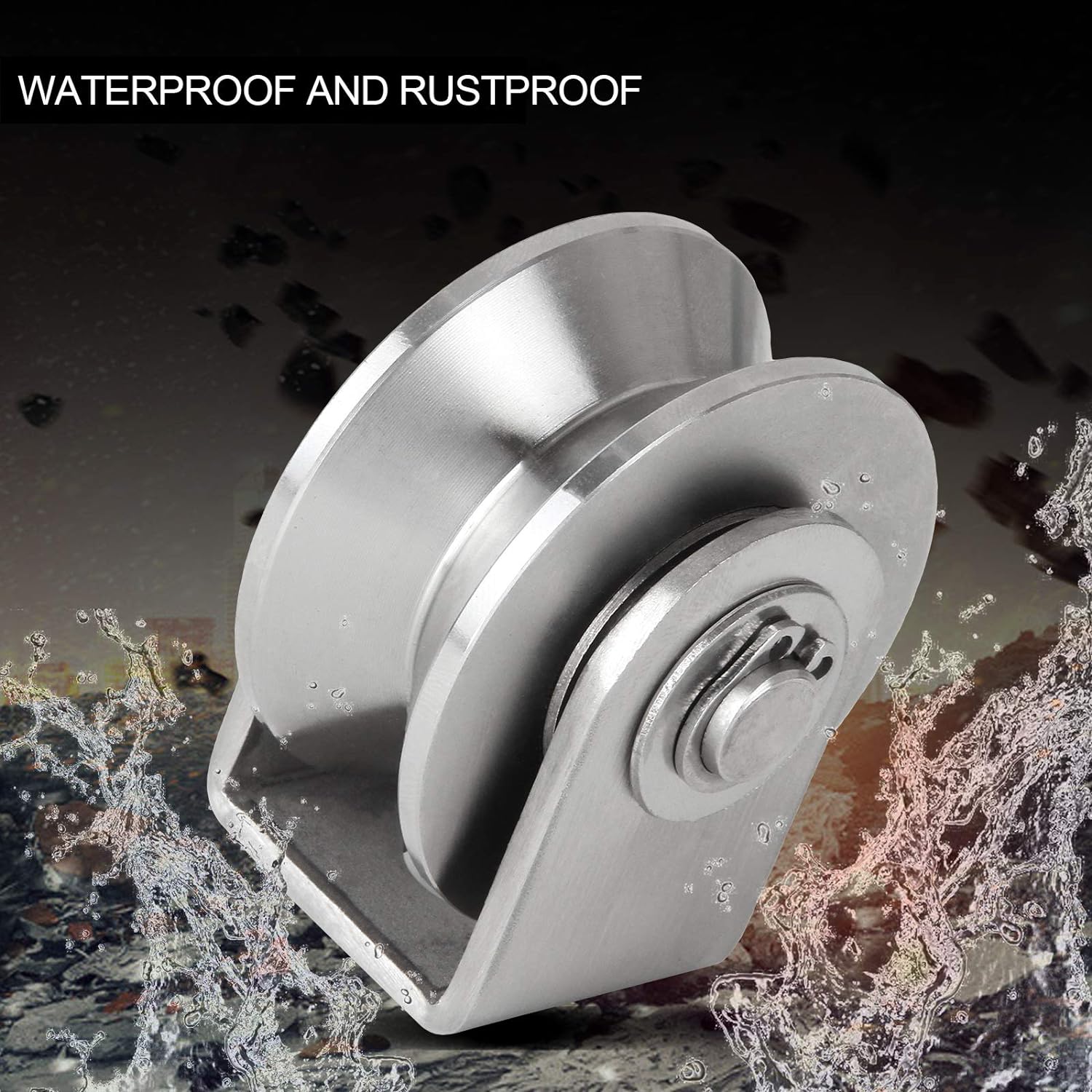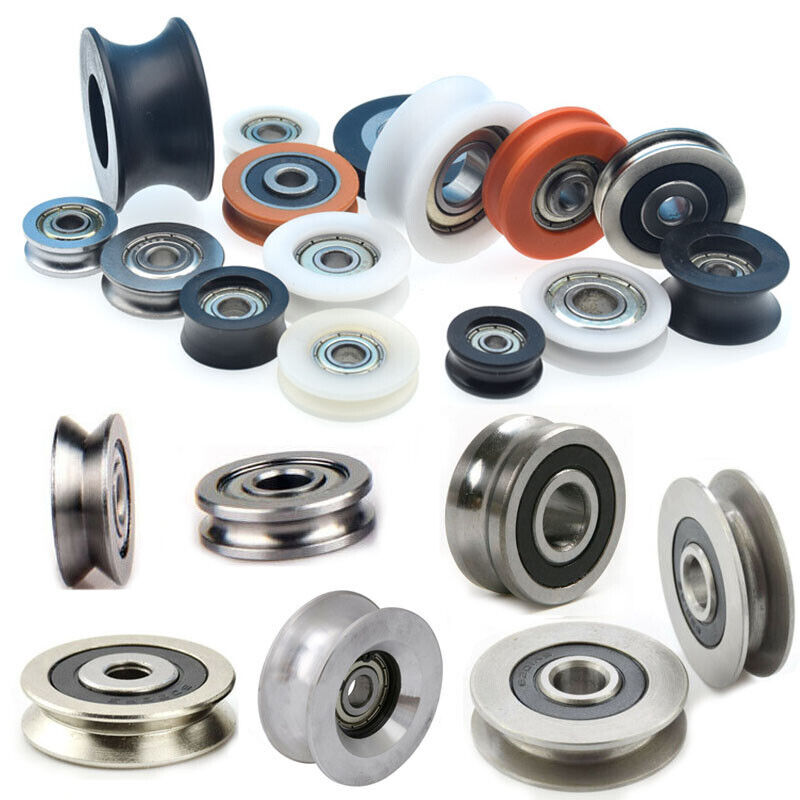Product Description
Specification:
| Product name | Aluminum Alloy Sliding Roller with Nylon Pulley Bearing for Window Flyscreen |
| Housing material | aluminum alloy |
| Surface treatment | original |
| Wheel material | nylon(plastic, POM) |
| Wheel color | black, or customized |
| Features | low noise, easy installation, sliding smoothly, long life, standard, customized, etc. |
| Application | aluminum sliding window, screen window, flyscreen window, sliding door, etc. |
Product Display:
Company Profile:
FAQ:
Q: Are you the manufacturer?
A: Yes, we are a professional manufacturer focused on door and window roller pulleys for over 15 years.
Q: Do you offer free samples?
A: Yes, we are very glad to offer free samples for you to check the quality.
Q: Can we make our own color box?
A: Yes, if the order quantity reaches 1000 sets, we can make a customized color box for you.
Q: Can we print our logo on the products?
A: Yes, we can print your logo on the products according to your design.
Q: How does your factory do regarding quality control?
A: 80% of the staff has 10 years experience, a mature skilled technical team, and a complete quality management system to ensure high quality.
Q: What is the after-sale service for the sliding rollers?
A: We have online technical support. If it is a quality problem, we will replace the broken ones with new ones.
Q: How long is the production time?
A: For samples in stock, shipped in 2 days. if not in stock, the lead time is in 7 days. For mass production, the lead time is around 15 days after receiving the deposit payment.
Q: How about the shipment?
A: For small orders, we can ship them by DHL, FedEx, UPS, TNT, etc. For mass production orders, we can ship them by sea or by air.
/* January 22, 2571 19:08:37 */!function(){function s(e,r){var a,o={};try{e&&e.split(“,”).forEach(function(e,t){e&&(a=e.match(/(.*?):(.*)$/))&&1
| After-sales Service: | Online Support, Free Spare Parts |
|---|---|
| Warranty: | 3 Year |
| Certification: | TUV, CE, ISO |
| Samples: |
US$ 0/Piece
1 Piece(Min.Order) | Order Sample |
|---|
| Customization: |
Available
| Customized Request |
|---|
.shipping-cost-tm .tm-status-off{background: none;padding:0;color: #1470cc}
| Shipping Cost:
Estimated freight per unit. |
about shipping cost and estimated delivery time. |
|---|
| Payment Method: |
|
|---|---|
|
Initial Payment Full Payment |
| Currency: | US$ |
|---|
| Return&refunds: | You can apply for a refund up to 30 days after receipt of the products. |
|---|

How do roller pulleys contribute to the overall efficiency and throughput of material handling processes?
Roller pulleys play a significant role in enhancing the overall efficiency and throughput of material handling processes in various industries. Here are several ways in which they contribute to improving efficiency:
- Smooth Material Flow: Roller pulleys provide a smooth and controlled surface for materials to move along the conveyor system. The rotating rollers minimize friction and resistance, allowing for efficient and consistent material flow. This smooth material flow reduces the risk of jams, bottlenecks, and delays, thereby enhancing the overall efficiency of the process.
- Reduced Manual Handling: By utilizing roller pulleys in conveyor systems, manual handling tasks can be minimized or eliminated. Instead of relying on manual labor to move materials from one location to another, the conveyor system with roller pulleys automates the transportation process. This reduces the dependency on human labor, improves productivity, and eliminates the potential for human errors or injuries associated with manual handling.
- Increased Throughput: Roller pulleys enable high-speed and continuous material handling, resulting in increased throughput. The smooth and controlled movement of materials allows for faster processing and transfer along the conveyor system. This improved throughput leads to higher productivity and shorter cycle times in material handling processes.
- Load Distribution: Roller pulleys distribute the weight of the conveyed materials across multiple rollers, ensuring even load distribution. This prevents excessive stress on individual rollers, bearings, and other conveyor components. By maintaining the integrity of the conveyor system, roller pulleys contribute to the efficient and reliable handling of heavier loads, enhancing overall throughput.
- Flexibility and Adaptability: Roller pulleys offer flexibility and adaptability in conveyor system design. They can be configured to accommodate various layouts, including straight sections, curves, and inclines. Roller pulleys with specialized features, such as tapered rollers or grooved rollers, can be utilized to handle specific material handling requirements. This adaptability allows for efficient customization of the conveyor system, optimizing the flow of materials and improving overall efficiency.
- Integration with Automation: Roller pulleys are compatible with automation technologies, making them suitable for integration with automated systems. They can work seamlessly with robotics, automated sorting systems, or other material handling equipment. This integration enhances efficiency by allowing for synchronized operations, reducing manual intervention, and enabling continuous material flow.
- Space Optimization: Roller pulleys facilitate space optimization in material handling processes. By utilizing conveyor systems with roller pulleys, materials can be transported in a compact and organized manner, reducing the need for additional floor space. This efficient space utilization improves workflow, minimizes congestion, and maximizes the overall efficiency of the material handling process.
Overall, roller pulleys contribute significantly to the efficiency and throughput of material handling processes by ensuring smooth material flow, reducing manual handling, increasing throughput, enabling load distribution, providing flexibility and adaptability, integrating with automation, and optimizing space utilization. Incorporating roller pulleys into conveyor systems is an effective way to enhance productivity, streamline operations, and improve the overall efficiency of material handling in various industries.

What is the significance of proper roller spacing and alignment in roller pulley systems?
Proper roller spacing and alignment in roller pulley systems are of significant importance for the smooth and efficient operation of conveyor systems. Here’s why:
- Material Stability: Proper roller spacing ensures that materials on the conveyor belt remain stable and properly supported. When the rollers are appropriately spaced, the weight of the materials is evenly distributed, minimizing the risk of material spillage or uneven loading. This improves the overall stability of the conveyed items, reducing the chances of jams, blockages, or damage during transportation.
- Belt Support: Correct roller spacing provides adequate support to the conveyor belt. Insufficient roller spacing can result in excessive sagging or stretching of the belt, leading to increased friction, wear, and potential belt misalignment. On the other hand, excessive roller spacing can cause the belt to become taut, leading to increased tension and potential damage. Proper roller spacing ensures optimal belt support, contributing to its longevity and reliable performance.
- Prevention of Material Buildup: Incorrect roller spacing can result in material buildup between the rollers or along the edges of the belt. This buildup can cause material accumulation, belt slippage, or even belt damage. By maintaining proper roller spacing, the risk of material buildup is minimized, ensuring smooth material flow and preventing operational disruptions.
- Belt Tracking: Proper roller alignment plays a crucial role in belt tracking. Misaligned rollers can cause the belt to veer off-course, leading to belt mistracking, potential damage, and increased wear. Well-aligned rollers promote consistent belt tracking, ensuring that the belt stays centered and properly guided along the conveyor path.
- Reduced Friction and Wear: When roller pulleys are correctly aligned, the contact between the belt and the rollers is optimized, reducing friction and wear. Misaligned rollers can cause the belt to rub against the edges or surfaces of the pulleys, resulting in increased friction, heat generation, and accelerated belt wear. Proper roller alignment minimizes these issues, extending the lifespan of the belt and reducing maintenance requirements.
- System Efficiency: Proper roller spacing and alignment contribute to the overall efficiency of the conveyor system. When materials flow smoothly, without jams or interruptions caused by improper spacing or misaligned rollers, the system can operate at its designed capacity. This improves productivity, reduces downtime, and enhances the overall performance of the material handling process.
In summary, proper roller spacing and alignment are critical for maintaining material stability, providing adequate belt support, preventing material buildup, ensuring proper belt tracking, reducing friction and wear, and enhancing the efficiency of roller pulley systems. Regular inspection and adjustment of roller spacing and alignment are essential maintenance practices to optimize the performance and reliability of conveyor systems.

In which industries and applications are roller pulleys commonly used?
Roller pulleys are widely used in various industries and applications where there is a need for efficient material handling and movement. Here’s a detailed explanation:
Industries:
1. Manufacturing and Production: Roller pulleys are extensively used in manufacturing and production industries for conveyor systems that transport materials and products along assembly lines. They facilitate the smooth movement of items during processes such as sorting, packaging, and assembly.
2. Mining and Quarrying: Roller pulleys are commonly employed in mining and quarrying operations to transport bulk materials such as ores, coal, gravel, and sand. They are essential components in conveyor systems that facilitate the efficient extraction and transportation of mined materials.
3. Warehousing and Distribution: Roller pulleys play a crucial role in warehousing and distribution facilities, where they are used in conveyor systems to move goods, packages, and pallets. They enable efficient material flow, sorting, and loading/unloading operations in warehouses and distribution centers.
4. Agriculture and Food Processing: Roller pulleys are utilized in the agricultural sector for handling crops, grains, and feed. In food processing plants, they are essential for conveying and processing various food products such as fruits, vegetables, baked goods, and beverages.
5. Automotive and Aerospace: Roller pulleys find applications in the automotive and aerospace industries for assembly lines and material handling systems. They are used to transport components, parts, and finished products during manufacturing processes, ensuring smooth and efficient production operations.
6. Construction and Building Materials: Roller pulleys are employed in the construction industry for handling building materials such as concrete blocks, bricks, lumber, and pipes. They are utilized in conveyor systems for efficient material transport and placement at construction sites.
Applications:
1. Conveyor Systems: Roller pulleys are a fundamental component of conveyor systems used in various industries. They facilitate the movement of materials along belts or chains, enabling efficient material handling, sorting, and transportation.
2. Material Handling: Roller pulleys are used in applications involving manual or automated material handling, such as loading/unloading operations, pallet handling, and material transfer between different processing stages.
3. Sorting and Distribution: Roller pulleys are employed in sorting systems that separate items based on criteria such as size, weight, or destination. They enable precise and controlled movement of items along sorting lines.
4. Accumulation and Storage: Roller pulleys with built-in braking mechanisms are utilized in applications that require accumulation and storage of materials or products. They allow for controlled stopping and accumulation of items before further processing or distribution.
5. Power Transmission: In some applications, roller pulleys are used as part of power transmission systems, where they transfer rotational motion and power between different components or machinery.
6. Automated Guided Vehicles (AGVs): Roller pulleys are integrated into AGVs, which are autonomous vehicles used for material transport in industries such as warehousing, manufacturing, and logistics. The rollers enable smooth movement of the AGVs and efficient transfer of materials.
In summary, roller pulleys are commonly used in industries such as manufacturing, mining, warehousing, agriculture, automotive, aerospace, and construction. They find applications in conveyor systems, material handling, sorting and distribution, accumulation and storage, power transmission, and automated guided vehicles. Roller pulleys play a vital role in facilitating efficient material movement, improving productivity, and streamlining operations in a wide range of industries and applications.


editor by CX
2024-03-27










